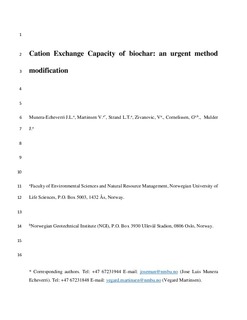| dc.description.abstract | Biochar, produced through pyrolysis of organic matter, is negatively charged, thus contributing to electrostatic adsorption of cations. However, due to its porous structure and contents of alkaline ashes, the determination of the cation exchange capacity (CEC) is challenging. Literature values for the CEC of biochar are surprisingly variable and are often poorly reproducible, suggesting methodological problems. Here, we modify and critically assess different steps in the existing ammonium acetate (NH4OAc) method (pH 7), where ammonium (NH4+) is displaced by potassium chloride (KCl), following removal of excess NH4OAc with isopropanol, in batch mode. We used pigeon pea biochar to develop the method and conducted a test on three additional biochars with different acid neutralizing capacity. A pretreatment step of biochar was introduced, using diluted hydrochloric acid, to decrease biochar pH to near neutral, so that 1 M NH4OAc effectively buffers the biochar suspension pH at 7. This allows the CEC of all biochars to be determined at pH 7, which is crucial for biochar comparison. The dissolution of ashes may cause relatively large weight losses (e.g. for cacao shell biochar), which need to be accounted for when computing the CEC of raw biochar. The sum of NH4OAC-extractable base cations provided a smaller and better estimate of the CEC than KCl-extractable NH4+. We hypothesize that the overestimation of the CEC based on KCl-extractable NH4+ is due to the ineffectiveness of the relatively large isopropanol molecules to remove excess NH4OAc in biochars rich in micro-pores, due to size exclusion. The amount of base cations removed in the pretreatment was about three (rice husk biochar) to ten times (pigeon pea biochar) greater than the amount of exchangeable cations. The CEC values of biochar increased from 10.8 cmol/Kg carbon to 119.6 cmol/Kg carbon. These values are smaller than reported CEC values of soil organic carbon. | |
